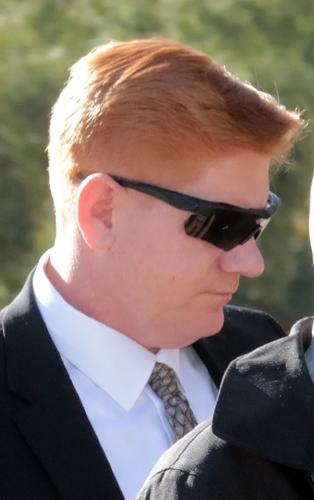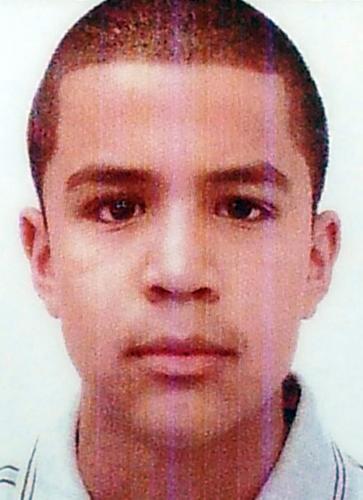The defense’s first witness contradicted herself during the second-degree murder trial of former Border Patrol agent Lonnie Swartz and didn’t back up a defense lawyer’s opening statement to jurors.
Swartz is accused of shooting through the border fence in Nogales on Oct. 10, 2012, killing 16-year-old Jose Antonio Elena Rodríguez, who was on the Mexican side.
One of the defense’s central arguments is that the Mexican teen was part of a group of drug smugglers and had been in the United States illegally as part of that operation the night of the shooting.
The defense began its case Thursday by trying to establish Elena Rodríguez had been on the U.S. side. But its first witness, identified only as A.O., gave a different account than she had to investigators about seeing him by her house near the border fence in Nogales, Ariz., or hearing the shots. She also said she didn’t know the teen, which differed from what she previously told investigators.
After what became a very short testimony for the 60-year-old woman, the defense decided to stop asking her questions and to instead call a government agent and its own investigator to testify about what she had told them.
Earlier that day, the prosecution rested its case after nearly three weeks of testimony from agents and officers at the scene and experts.
The jury on March 29 went to the site of the shooting to see what the area looked like during day and night.
The government’s case is that Swartz had other options when he shot 16 times in 34 seconds, striking Elena Rodríguez in the back and head 10 times.
Prosecutors also spent several days focusing on the Mexican investigation and autopsy, to establish which was the fatal shot and attempting to show that Elena Rodríguez was alive when the agent changed positions, fired again and reloaded after the teen was already on the ground.
A large part of the week involved gruesome photos from the crime scene, showing individual gunshot wounds and the damage they did to Elena Rodríguez’s body. During that testimony, his family was in a jury room to listen to the audio but avoid seeing the images.
Two competing scenarios are being presented:
- The defense’s position is that Elena Rodríguez was killed by one of the first shots to the head, causing him to lose control and fall to the ground, which the defense says would make the rest of the gunshots legally irrelevant.
- The prosecution’s case is that the teen was first hit in the back, causing him to fall to the ground, but was alive for most of the other shots until the fatal shot to the head.
The prosecution’s positions:
Fatal shot
Elena Rodríguez was possibly running when he was hit in the back by a bullet that left him paralyzed from the waist down and caused him to fall to the ground, hitting the left side of his face and scraping the back of his hands.
Then, according to the prosecution, he probably lifted himself up briefly, raised his left arm and was struck by the other 10 bullets.
One of the last bullets transected his brain and became lodged in his forehead, causing him to hit the ground before turning his face to the final resting position, prosecutors say.
This was the testimony of Emma Lew, one of the last witnesses called by the government. She is director of the Miami-Dade County Medical Examiner Department in Florida. Lew examined photographs, videos, reports (including autopsy, ballistics and toxicology), visited the scene and spoke with the Mexican medical examiners who performed the autopsy to form her conclusion.
On Thursday, she used a mannequin and 18-inch knitting needles to show and narrate to the jury the trajectory of each of the 10 shots. She couldn’t offer the exact order of the shots, but said she could tell which had to come before others.
Based on the movement of the head and arm, the amount of blood found in the lungs and cardiac cavities, and the trajectory of some of the shots, she said she could conclude the first shot was to the back. It struck several vertebrae and left Elena Rodríguez paralyzed, but was not immediately fatal.
The first one was not the shot to the head, from which he would have died within seconds or a couple of minutes, she said.
Sean Chapman, one of the two defense attorneys representing Swartz, brought up the fact that Lew had not been provided with handwritten notes from a U.S. attorney. In those, the Nogales medical examiner, Dr. Javier Díaz Trejo, had said he thought the first shot was the fatal shot to the head.
Lew responded, “It’s OK, that’s Dr. Diaz’s opinion.”
During his testimony, Dr. Absalon Madrigal Godinez, the other medical examiner who performed the autopsy, said that when they gave that opinion, they didn’t have all the information they have today.
“As Mexican investigators, we were missing information from the other side of the border,” he said.
Chapman also pointed out to Lew that Madrigal had said it was possible that Elena Rodríguez hit his face and back of his hands with the wall as he was shot behind the right ear and that he was killed instantly.
Lew responded it was possible, but based on how he fell and the distance from the wall, she believed he fell from the shot to the middle of his back.
Chapman also questioned how Elena Rodríguez could have used his hands to arrest his fall even after being paralyzed from the waist down, as Lew said.
“It happened so quickly, you have to think about it, to put his hands down,” she said.
“Isn’t it speculation on your part?” Chapman countered. “It did happen quickly,” she responded.
Taking cover
The agents and officers at the scene could have taken cover or escaped the situation when Swartz killed Elena Rodríguez in response to rock throwers, an expert witness called by the prosecutors testified Monday.
Allen Foraker, a former Border Patrol supervisor and member of the agency for nearly 30 years until his retirement in 2013, also said that if an agent shot someone in the back who no longer had a potentially lethal weapon in hand, it would be an unjustified shooting.
“He should not have shot,” he said in response to Assistant U.S. Attorney Wallace Kleindienst’s repeated questions about agents being trained to shoot in the center mass of the target. “It’s not a justified shooting.”
He also testified about the use-of-force handbook and training, which he taught during his time at the Border Patrol academy in Artesia, New Mexico, where students included Swartz.
“In your experience, was there cover?” Kleindienst asked. There were vehicles, from both the Border Patrol and the Nogales Police Department, a building and a tree, he responded.
Agents weren’t caught in a situation with no ability to escape, he said.
“The area to the north was not congested, there was a clear, open safe space,” where they could have avoided the threat, he testified.
While they are not taught they must always take cover, Foraker said that is a sound tactical move.
Chapman has said Swartz heard that a police dog and a fellow agent had been hurt by rocks already and was acting to avoid injury to himself and to prevent someone else from being seriously injured or killed.
Foraker said an animal being in danger or injured doesn’t justify the use of lethal force, based on the federal agency’s policy.
“Bottom line,” Chapman said, “the decision to shoot someone takes place in a blink of an eye. We have to try to put ourselves in the shoes of the agent and understand these are split-second decisions.”
Legitimacy of Mexican investigation
Several Mexican police officers and investigators also took the stand in the last week, mostly to explain their procedures and protocols.
From the beginning of the trial, the defense has said there were missteps with the investigation on both sides of the border, including a Mexican police officer possibly kicking the body, and what appeared to be officers picking things up from the scene and putting them in their pockets.
Juan Pablo Espinoza Armenta, a Nogales police officer and one of the first to arrive on scene, said what is shown on the surveillance video from Border Patrol cameras is actually officers picking up rocks to use as evidence markers.
Chapman expressed skepticism, since the officer hadn’t mentioned that in previous meetings with prosecutors.
Each Mexican officer who took the stand testified that neither they nor anyone they could see had touched the body or the evidence until Roberto Tapia, the state prosecutor and investigator in charge of the investigation, arrived later that night.
The defense’s positions:
Smuggling operation
During his opening statement, Chapman told the jury about a witness who lives close to the border and saw Elena Rodríguez by her house on the U.S. side, and an FBI informant who had information about the teen being part of the smuggling operation that night.
He painted a picture of a dangerous situation in which Elena Rodriguez’s actions ultimately caused his death.
But on Thursday, the witness identified as A.O. walked back what investigators said she told them.
“Didn’t you tell agent (Sarah) Arrasmith that your grandson went to school with him in Mexico?” Chapman asked her.
“I don’t remember having said that,” she said through an interpreter.
Chapman continued to ask her about the day of the shooting and hearing noises and the shots outside, but A.O. kept saying the statements were untrue. Then she said she didn’t know by name the teen who had been shot, but had seen him running by her house and being chased by Border Patrol agents with long weapons — but none of the agents testified they had such weapons.
Eventually, Chapman asked for a meeting with the other attorneys and the judge. He then asked the witness, “Are you afraid?”
“Of what?” she responded. “Are you fearful right now as you testify?” Chapman asked. “No,” she said.
“No further questions,” Chapman told the judge.
An FBI informant told investigators and later Chapman that two people he knew said Elena Rodríguez was part of a group smuggling drugs. Chapman read the transcript of the interview with the help of co-counsel Jim Calle.
“Señor,” as the informant was identified, said he heard about the shooting and went to the crime scene, where he ran into “El Pato” and “El Chopin.”
They were hiding nearby and told him that immigration agents had shot at them — “that the whole thing had gone to hell,” said Señor, the informant.
“Anyone who would move, la migra (Border Patrol) would shoot at,” he said. The two told the informant that Elena Rodríguez was one of the last ones to jump the fence. That’s when they started to throw rocks at the agents and he was shot, they said.
Chapman also interviewed his investigator, Randy Downer, who testified about finding rust on the teen’s shoes and pants, consistent with someone who has climbed the border fence. The defense bought identical shoes to the ones Elena Rodríguez was wearing that night, to test on the fence in Nogales.
But during cross-examination, Kleindienst asked why Downer hadn’t asked the government for the actual clothing to conduct a test to determine whether it was rust.
“It could be rust, it could be dirt, it could be rust, right? You can’t assume the substance was necessarily rust?” he asked.
“Unequivocally? No,” Downer responded.
The trial will continue Monday in Judge Raner Collins’ courtroom in U.S. District Court in Tucson, with defense attorneys presenting their own forensic experts and witnesses.







